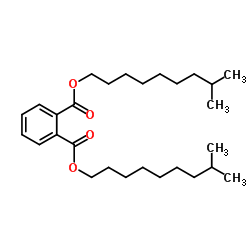Reomol DiDP

Reomol DiDP structure
|
Common Name | Reomol DiDP | ||
|---|---|---|---|---|
| CAS Number | 26761-40-0 | Molecular Weight | 446.662 | |
| Density | 1.0±0.1 g/cm3 | Boiling Point | 425.8±13.0 °C at 760 mmHg | |
| Molecular Formula | C28H46O4 | Melting Point | 235ºC | |
| MSDS | Chinese USA | Flash Point | 227.6±9.3 °C | |
| Symbol |

GHS09 |
Signal Word | Warning | |
|
Effects of endocrine disruptors on dehydroepiandrosterone sulfotransferase and enzymes involved in PAPS synthesis: genomic and nongenomic pathways.
Environ. Health Perspect. 115 Suppl 1 , 51-4, (2007) Sulfation plays an important role both in detoxification and in the control of steroid activity. Studies in rodents have shown that the conversion of dehydroepiandrosterone (DHEA) to DHEA-sulfate is involved in learning and the memory process.The effects of a... |
|
|
Adjuvant effect of di-n-butyl-, di-n-octyl-, di-iso-nonyl- and di-iso-decyl phthalate in a subcutaneous injection model using BALB/c mice.
Pharmacol. Toxicol. 91(5) , 264-72, (2002) During the last decades, the prevalence of the allergic airway diseases, asthma and rhinitis, has increased world-wide. Introduction of environmental chemicals with adjuvant effect may play a role in this increase. In the present study, the adjuvant effects o... |
|
|
Effects of phthalates on the human corneal endothelial cell line B4G12.
Int. J. Toxicol. 31(4) , 364-71, (2012) Phthalates are industrial chemicals used in many cosmetics. We evaluated an in vitro model for eye irritancy testing using the human corneal endothelial cell line B4G12. Cell proliferation and toxicity were assessed after exposing to di-n-butyl phthalate (DBP... |
|
|
Phthalate exposure during cold plastisol application--a human biomonitoring study.
Toxicol. Lett. 213(1) , 100-6, (2012) The phthalates DEHP (Diethylhexyl phthalate), DiNP (Diisononyl phthalate) and DiDP (Diisodecyl phthalate) are constituents of plastisols. We sought to obtain first data on occupational exposures to the above phthalates by analyzing their metabolites in pre- a... |
|
|
Hazard evaluation of diisononyl phthalate and diisodecyl phthalate in a Japanese medaka multigenerational assay.
Ecotoxicol. Environ. Saf. 65(1) , 36-47, (2006) Reproductive and developmental effects of diisononyl phthalate (DINP) and diisodecyl phthalate (DIDP) were evaluated in a Japanese medaka (Oryzias latipes) multigeneration protocol. Each phthalate was administered via fish flake diets at a concentration of 20... |
|
|
Selecting adequate exposure biomarkers of diisononyl and diisodecyl phthalates: data from the 2005-2006 National Health and Nutrition Examination Survey.
Environ. Health Perspect. 119(1) , 50-5, (2011) High-molecular-weight phthalates, such as diisononyl phthalate (DINP) and diisodecyl phthalate (DIDP), are used primarily as polyvinyl chloride plasticizers.We assessed exposure to DINP and DIDP in a representative sample of persons ≥ 6 years of age in the U.... |
|
|
Human biological monitoring of diisononyl phthalate and diisodecyl phthalate: a review.
J. Environ. Public Health 2012 , 810501, (2012) High molecular-weight phthalates, such as diisononyl phthalate (DINP), and diisodecyl phthalate (DIDP), are widely used as plasticizers in the manufacturing of polymers and consumer products. Human biological monitoring studies have employed the metabolites o... |
|
|
Plasticizers in Brazilian food-packaging materials acquired on the retail market.
Food Addit. Contam. 23(1) , 93-9, (2006) Packaging materials intended for direct food contact were acquired on the Brazilian retail market and analysed for their plasticizer content. Analyses were carried out by gas chromatography with flame ionization detection. Di-2-ethyl-hexyl adipate (DEHA), di-... |
|
|
Peroxisome proliferator di-isodecyl phthalate has no carcinogenic potential in Fischer 344 rats.
Toxicol. Lett. 178(2) , 110-6, (2008) Di-isodecyl phthalate (DIDP), a peroxisome proliferator-activated receptor-alpha activator, is widely used as a plasticizer in the manufacture of polyvinyl chloride (PVC), and ultimately in typical vinyl applications, particularly wire, cable and toys, etc. T... |
|
|
Allergic contact dermatitis from di-isodecyl phthalate in a polyvinyl chloride identity band.
Contact Dermatitis 29(2) , 94-5, (1993)
|